Back to Journals » International Journal of General Medicine » Volume 16
A Study on the Regularity of Acupoint Match Based on Association Rules with SP6 as the Main Acupoint and Its Clinical Application
Authors Cheng W , Zhang L , Chen B, Tian X, Yao Y, Zhang Z, Chen S
Received 2 October 2023
Accepted for publication 11 November 2023
Published 4 December 2023 Volume 2023:16 Pages 5675—5693
DOI https://doi.org/10.2147/IJGM.S441978
Checked for plagiarism Yes
Review by Single anonymous peer review
Peer reviewer comments 2
Editor who approved publication: Dr Woon-Man Kung
Weilu Cheng,1,* Lili Zhang,1,* Biwei Chen,1 Xin Tian,1 Yaqi Yao,1 Zezhou Zhang,1 Shaozong Chen2,3
1Shandong University of Traditional Chinese Medicine, Jinan, Shandong, People’s Republic of China; 2Institute of Acupuncture and Moxibustion and Massage, Shandong University of Traditional Chinese Medicine, Jinan, Shandong, People’s Republic of China; 3Shaozong Chen, Cross-Regional Acupuncture Data Open Application Laboratory in the Yellow River Basin, Jinan, Shandong, People’s Republic of China
*These authors contributed equally to this work
Correspondence: Shaozong Chen, Cross-regional Acupuncture Data Open Application Laboratory in the Yellow River Basin, Jinan, 250355, People’s Republic of China, Email [email protected]
Objective: This study aims to explore formula patterns and application rules for SP6 as the main acupoint in prescriptions, utilizing association rules.
Methods: We conducted an extensive search in databases including China National Knowledge Infrastructure (CNKI), Wanfang Data Knowledge Service Platform (CDDB), China Science and Technology Journal Database (CSTJ), PubMed and Web of Science databases for literature published between January 2013 and June 2023, focusing on acupuncture prescriptions with SP6 as the main acupoint for various diseases. Inclusion and exclusion criteria were applied for literature screening. Relevant data was extracted, creating a database. Acupoints in conjunction with SP6 were analyzed using SPSS Modeler 18.0 and Cytoscape 3.7.2 software for acupoints appearing ≥ 15 times. Gephi software constructed a complex network model. The frequency of acupuncture points was analyzed to summarize the composition rules and clinical application rules of acupuncture points.
Results: A total of 902 articles met inclusion criteria, yielding 672 prescriptions with SP6 as the main acupoint, paired with 197 different acupoints including ST36, CV4, and LI4. Neurological, obstetric, and gynecologic, as well as urological diseases, were predominantly treated. Among them, the predominant diseases include insomnia, primary dysmenorrhea, sequelae of stroke, and others, totaling 42 types.
Conclusion: SP6-based prescriptions exhibit diverse applications, effectively treating insomnia, post-stroke sequelae, and primary dysmenorrhea. Commonly paired acupoints belong to Conception Vessel, Stomach meridian of foot-yangming, and Governor Vessel, and there are certain rules in their composition.
Keywords: Sanyinjiao, SP6, acupuncture prescriptions, acupoint combinations regularity, application regularity
Introduction
SP6 is derived from “The AB Classic of Acupuncture and Moxibustion”1 as follows: “SP6 is located triple cun above the medial malleolus, in a depression behind the tibia. It is the crossing point of the meridians of Foot-Taiyin, Foot-Jueyin, and Foot-Shaoyin”.2 This acupoint is thus named Sanyinjiao and is known for its functions of promoting the blood flow to regulate menstruation, clear the liver, tonifying kidney and spleen, dispelling wind and dampness, and activating meridians. It is mainly used in the treatment of gynecological disorders, gastric conditions, and liver and gallbladder diseases.3 In this study, IBM SPSS Modeler 15.0 software and data mining methods were used to analyze the frequency of acupoints containing SP6, as well as high-confidence association rules, based on data obtained from databases such as China National Knowledge Infrastructure (CNKI), Wanfang Data Knowledge Service Platform (CDDB), China Science and Technology Journal Database (CSTJ), PubMed, and Web of Science. The analysis aims to provide references for the clinical application of SP6 and to contribute to the deeper exploration and inheritance of the acupoint match and clinical application rules in acupuncture and traditional Chinese medicine.
Materials and Methods
Search Strategy
The data for this study mainly came from the retrieval of Chinese databases, including CNKI, CDDB and CSTJ, using the keyword “Sanyinjiao”. Simultaneously, English databases such as PubMed and Web of Science were searched using the keywords “Sanyinjiao” OR “SP6”. The retrieval period was from January 1, 2013, to June 29, 2023. Relevant literature related to the main prescriptions using SP6 as the primary acupoint was selected, resulting in a total of 9277 retrieved records.
Inclusion and Exclusion Criteria
Inclusion Criteria
- Literature type is clinical research.
- Provide accurate acupuncture treatment prescriptions, and at the same time select the literature of the acupuncture points with SP6 as the main acupoints.
- Literature with standardized and reasonable research methods.
- Literature with clearly defined therapeutic effects.
- General clinical summary ≥65 cases, randomized controlled clinical trials ≥30 cases of literature.
Exclusion Criteria
- Literature of animal experiments, literature reviews, case reports, or reviews.
- Literature with less than 65 cases for general clinical summaries, and less than 30 cases for randomized controlled clinical trials.
- Literature that does not provide explicit prescriptions or does not include SP6 as the main acupoint.
- Duplicate literature.
- Literature with unclear therapeutic effects or uncertain efficacy of acupuncture treatment.
Data Standardization
Reference to the standardization of acupoint names in “Nomenclature and Location of Acupoints” (GB/T 12346–2021) and “Meridians and Acupoints (3rd edition)”,1,4 and refer to the “Common Clinical Medical Terminology (2019 Edition)”. If not listed in the reference book, the information from the literature will be used as the standard.
Data Entry
Two individuals were selected to conduct the literature screening. Initially, the literature was entered into the NoteExpress software for preliminary deduplication. Then, based on the inclusion and exclusion criteria, a preliminary screening of titles and abstracts was performed to eliminate irrelevant literature. Full-text reading was conducted to confirm the inclusion of relevant literature. Next, the two individuals independently performed data extraction and established the database according to the inclusion and exclusion criteria mentioned earlier. A total of 902 valid literatures were collected, out of which 72 literatures specifically used SP6 as the acupoint alone, while the remaining 830 literatures used SP6 in combination with other acupoints for treatment. In this study, a total of 672 acupoint prescriptions were collected, including details of acupoint names and their corresponding meridians. The database was established using Microsoft Excel software.
Statistical Methods
The meridian categories, matching acupoints, disease department categories, main diseases and other types of the SP6 were summarized and counted. For acupoint statistics, Microsoft Excel software was used. The Apriori algorithm from SPSS Modeler 15.0 software was employed for association analysis of acupoints used 15 times or more. Additionally, Cytoscape 3.9.1 software and Gephi 0.97 software were used for complex network analysis.
Results
Search Results
Figure 1 illustrates the process of inclusion and exclusion. A total of 9277 potentially relevant records were identified from five databases, and after the software check 7848 articles remained. The titles and abstracts of 7848 records were initially screened and 3817 records were excluded. The remaining 4031 studies were screened for full texts, of which 3130 were excluded. Therefore, we included a total of 902 studies here.
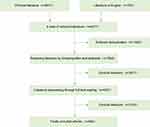 |
Figure 1 Literature retrieval flowchart. |
With the development of evidence-based medicine, randomized controlled trials (RCTs) have become the gold standard for comparing the effectiveness of different interventions, which can avoid possible bias and confounding factors in the design of clinical trials, so this study first evaluated the 902 included articles based on the items in the CONSORT statement (2010 edition)5 list (Table 1), and the results showed that 97.45% of the articles explained the scientific background and the rationale for the experiment, and 52.44% of the articles gave specific purposes or hypotheses; 94.46% of the studies described the main interventions and outcomes, 89.91% of the articles described the method of using the allocation sequence, 6.87% of the studies were blinded, 86.25% of the studies described the statistical methods, and most of the articles proposed follow-up but did not inform the follow-up time; 40.91% of the studies described baseline data for participants; Some studies lacked reporting on study limitations and the possibility of replication of the trial, as well as registry numbers and registries.
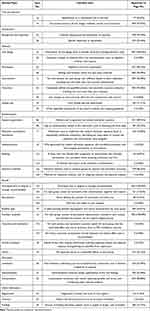 |
Table 1 Literature Quality Evaluation Form (CONSORT STATMENT) |
In all the included literatures, there are a total of 258 commonly used acupuncture points for acupuncture prescriptions with SP9 as the main acupoint, including 176 acupoints belonging to the Twelve Regular Meridians, 16 acupoints belonging to the Conception Vessel, 16 acupoints belonging to the Governor Vessel, and 50 acupoints belonging to the Extra Points. The dominant department categories of SP6 are mainly neurology and obstetrics and gynecology, and the specific diseases mainly include insomnia, stroke sequelae and primary dysmenorrhea. For the treatment of sequelae of stroke, SP6 is often used to be compatible with PC6 and HT7; SP6 is often used for primary pain in combination with RN4 and HT7.
SP6 as the Main Governing Law of the Main Acupoint
Overview of Clinical Application of SP6 Alone
There was a total of 72 articles using only SP6 as the prescription. The top three treatment methods in terms of frequency were combination therapy (25 articles), acupoint injection (17 articles), and acupuncture (16 articles) (Table 2). The total frequency of main treated diseases using single SP6 acupoint as the prescription was 72 times, involving 22 different types of diseases. The diseases belonged to 11 different medical departments, with obstetrics and gynecology having the highest frequency (44 times) and the greatest variety (11 types) (Table 3). Based on the average frequency of each disease in the literature,6 diseases with frequencies greater than or equal to the average frequency (3.13) were considered preponderant. The dominant diseases included primary dysmenorrhea (26 times), urinary retention (14 times), labor induction (6 times), and analgesia (5 times). These diseases and treatment methods were recorded using Microsoft Excel and imported into Gephi software to construct a complex network relationship model (Figure 2). In the network model, the blue nodes represent single acupoints, the green nodes on the left represent preponderant disease and their medical departments, and the red nodes on the right represent treatment methods. The size of the nodes and the thickness of the connecting lines indicate the significance and frequency of their usage, the larger the node and the thicker the connecting line, the more important it is and the higher the frequency of use, and vice versa, the less important it is, the lower the frequency of use.
 |
Table 2 Intervention Methods for Single SP6 Acupoint |
 |
Table 3 Frequency Statistics of Clinical Applications Using Single SP6 Acupoint as the Prescription |
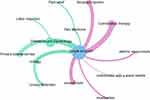 |
Figure 2 Single acupoint network diagram. Note: Only dominant diseases and their respective departments are shown. |
Overview of the Clinical Application of SP6 Acupoint Matching
Acupoint Intervention Methods and Clinical Applications
There were 830 prescriptions for the combination of SP6 as the main acupoint and multiple acupoints, and the top three treatments used were combination therapy (382 articles), acupuncture (247 articles), and electroacupuncture (77 articles) (Table 4). The total frequency of the main treatment of multi-acupoint prescriptions was 830 times, and the types of diseases were 198; There are a total of 22 types of diseases involved, with neurology leading the frequency (213) and obstetrics and gynecology (38) (Table 5). It is bounded by the average frequency of each condition in the literature, diseases with an average frequency greater than or equal to (4.19) are classified as preponderant conditions, and the preponderant diseases include: insomnia (81 times), stroke sequelae (68 times), primary dysmenorrhea (53 times) and other 42 diseases. The treatment methods and preponderant diseases of single-acupuncture literature were entered through Microsoft Excel and imported into Gephi software to build a complex network relationship mode l (Figure 3) with the blue node (multi-point matching) as the center, the green node in the left part is the dominant disease and its department, and the red node on the right is the treatment method, in which the larger the node and the thicker the connecting line, the heavier its proportion and the more frequency of use.
 |
Table 4 Intervention Methods for Multiple Acupoint Combinations in Treatment |
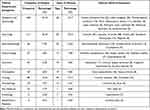 |
Table 5 Frequency Statistics of Clinical Applications Using SP6 in Combination with Multiple Acupoints as the Prescription |
 |
Figure 3 Multi-acupoint matching network diagram. Note: Only dominant conditions and their respective departments are shown. |
The Commonly Used Acupoints and Their Meridians When Mating with SP6
Among the 830 literature entries with acupoint combinations, a total of 256 acupoints were commonly used in combination with SP6. Among these, 176 acupoints belonged to the Twelve Regular Meridians, 16 acupoints belonged to the Conception Vessel, 15 acupoints belonged to the Governor Vessel, and 49 acupoints belonged to the Extra Points. The total frequency of these acupoints reached 6495 times, with 18 frequently used acupoints having a frequency exceeding 100 times, including DU20, ST36, RN4, LI4, PC6 (Only the top five acupuncture points of total frequency are listed). The Apriori algorithm in SPSS Modeler 15.0 software was used to analyze the association of high-frequency acupoints (frequency ≥15) (Table 6), to set the support degree greater than or equal to 15%, the degree of confidence ≥80%, the SP6 as the latter item, the confidence of the former item is 100%, and the degree of support alone is used to reflect the degree of association, and the degree of support and association degree are proportional (the same is true for subsequent association rule analysis). Among them, ST36 (51.205%), RN4 (27.590%), LI4 (23.735%) ranked in the top three, indicating that in the total item set, the probability of SP6 and ST36, RN4 and LI4 matching ranks in the top three. The frequency of acupoints in the meridians to which the SP6 match Conception Vessel (1222 times), Stomach meridian of foot-yangming (1130 times), and Governor Vessel (1065 times) ranked in the top three, and the number of acupoints through Extra Points (42), Bladder meridian of foot-taiyang (42), and Stomach meridian of foot-shaoyang (32) ranked in the top three (Table 7).
 |
Table 6 Association Rule Analysis of Acupoint Combinations in SP6 Multi-Acupoint Applications |
 |
Table 7 Commonly Used Combinations of Acupoints and Their Corresponding Meridians |
Clinical Application Law of SP6 Acupoint Matching
The total frequency of the main treatment of multi-acupuncture prescriptions was 830 times, and there were 198 types of diseases; There are a total of 22 types of disease departments, the frequency of neurology (213 times) and the frequency of obstetrics and gynecology (203 times) are the top two and their frequency far exceeds that of other department categories, the number of diseases is 198, insomnia (83 times), sequelae of stroke (68 times), primary dysmenorrhea (53 times) are the top three. Due to the large number of department categories and diseases, only neurology and obstetrics and gynecology were selected for the department category, and the top three frequent insomnia, stroke sequelae and primary dysmenorrhea were selected for clinical application statistics.
The Rule of Acupuncture Points for the Treatment of Neurology Conditions
The Apriori algorithm in SPSS Modeler 15.0 software was used to analyze the association of high-frequency acupoints (frequency ≥15) (Table 8), and the setting support degree was greater than or equal to 15%, and the confidence was ≥80%, and the single-acupoint matching single acupoint was the highest in DU20 (38.785%), indicating that in the total item set, the probability of SP6 and DU20 matching was 38.967%; The support of HT7 and DU20 (23.364%) was the highest, indicating that in the total item set, the probability of SP6 and HT7 and DU20 matching together was 23.474%. At the same time, the association data of high-frequency acupoints is imported into Cytoscape 3.9.1 software, and a complex network diagram is modeled and made. The larger the node, the thicker the connecting line and the darker the color, the higher the degree of association between acupoints (the same is true for obstetrics and gynecology and psychiatric network diagram) (Figure 4).
 |
Table 8 Analysis of Acupoint Matching Association Rules Applied in Neurology |
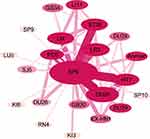 |
Figure 4 Relationship diagram of high frequency acupoint network in neurology. Note: Only acupoints with a link count greater than or equal to 15 are shown. |
The Rule of Acupuncture Points for the Treatment of Obstetrics and Gynecology Conditions
The Apriori algorithm in SPSS Modeler 15.0 software was used to analyze the association of high-frequency acupoints (frequency ≥15) (Table 9), and the support degree was set to be greater than or equal to 15%, and the confidence level was ≥80%. RN4 (52.709%) had the highest support for single acupuncture and single acupuncture, indicating that in the total item set, the probability of SP6 and RN4 matching was 52.709%; The support of ST36 and RN4 (20.197%) was the highest, indicating that in the total item set, the probability of SP6 matching with ST36 and RN4 was 20.197%. At the same time, the association data of high-frequency acupoints is imported into Cytoscape 3.9.1 software to model and make a complex network diagram, the larger the node, the thicker the connecting line and the darker the color, the higher the degree of association between acupoints (Figure 5).
 |
Table 9 Analysis of Acupoint Matching Association Rules Applied in Obstetrics and Gynecology |
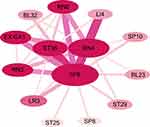 |
Figure 5 Relationship diagram of high frequency acupoint network in gynecology and obstetrics. Note: Only acupoints with a link count greater than or equal to 15 are shown. |
The Rule of Acupuncture Points for the Treatment of Insomnia Conditions
The Apriori algorithm in SPSS Modeler 15.0 software was used to analyze the correlation of high-frequency acupoints (frequency ≥15) (Table 10), and the support degree was set to greater than or equal to 15%, and the confidence level was ≥80%. The single point matching single point was the highest in HT7 (80.723%), indicating that in the total item set, the probability of SP6 and HT7 matching was 80.723%; multi-acupoint matching was the highest in DU20 and HT7 (45.783%), indicating that in the total item set, the probability of SP6 matching with HT7 and DU20 was 45.783%. At the same time, the association data of high-frequency acupoints is imported into Cytoscape 3.9.1 software to model and make a complex network diagram, the larger the node, the thicker the connecting line and the darker the color, the higher the degree of association between acupoints (Figure 6).
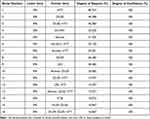 |
Table 10 Analysis of Acupoint Matching Association Rules Applied in Insomnia |
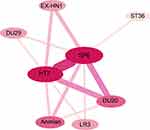 |
Figure 6 Relationship diagram of high frequency acupoint network in insomnia. Note: Only acupoints with a link count greater than or equal to 15 are shown. |
The Rule of Acupuncture Points for the Treatment of Sequelae of Stroke Conditions
The Apriori algorithm in SPSS Modeler 15.0 software was used to analyze the correlation of high-frequency acupoints (frequency ≥15) (Table 11), and the support degree was greater than or equal to 15%, and the confidence level was ≥80%. The support of PC6 (52.857%) was the highest, indicating that in the total item set, the probability of SP6 and PC6 matching was 52.857%; The support of multi-point matching is highest in DU26 and PC6 (30%), indicating that in the total item set, the probability of SP6 with DU26 and PC6 is 30%. At the same time, the association data of high-frequency acupoints is imported into Cytoscape 3.9.1 software, and a network diagram is modeled and made. The larger the node, the thicker the connection line and the darker the color, the higher the degree of association between acupoints (Figure 7).
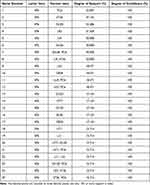 |
Table 11 Analysis of Acupoint Matching Association Rules Applied in Sequelae of Cerebral |
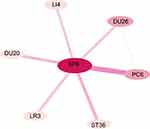 |
Figure 7 Relationship diagram of high frequency acupoint network in sequelae of stroke. Note: Only acupoints with a link count greater than or equal to 15 a. |
The Rule of Acupuncture Points for the Treatment of Primary Dysmenorrhea Conditions
The Apriori algorithm in SPSS Modeler 15.0 software was used to analyze the association of high-frequency acupoints (frequency ≥15) (as shown in Table 12), and the support degree was greater than or equal to 15%, and the confidence level was ≥80%. RN4 (76.786%) had the highest support for single acupuncture matching, indicating that in the total item set, the probability of SP6 and RN4 matching was 76.786%; The support of ST36 and RN4 (23.214%) was the highest, indicating that in the total item set, the probability of SP6 matching with ST36 and RN4 was 23.214%. At the same time, the association data of high-frequency acupoints is imported into Cytoscape 3.9.1 software, and a network diagram is modeled and made, the larger the node, the thicker the connection line and the darker the color, the higher the degree of association between acupoints (Figure 8).
 |
Table 12 Analysis of Acupoint Matching Association Rules Applied in Primary Dysmenorrhea |
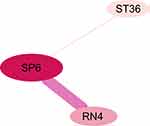 |
Figure 8 Relationship diagram of high frequency acupoint network in primary dysmenorrhea. Note: Only acupoints with a link count greater than or equal to 15 are shown. |
Discussion
Whether it is a single point treatment or a combination with SP6 multiple points, it is widely used in clinical practice, but the composition law and clinical application law of the SP6 as the main acupoint are still very few related studies from the perspective of modern medicine, although there is a similar article,7 the number of articles included is small, only 261 articles are included, and this article includes 902 articles, this article is basically the same as the first three times of the frequency of the article, acupoints, and meridians, and the specific order is different; It only analyzes the main treatment conditions involved in SP6, while this study provides a more detailed analysis of the dominant department categories and their dominant diseases in the clinical application of SP6. From the perspective of acupoint intervention methods, among the 902 clinical literatures included, the use of combination therapy was the most, accounting for 45.12%, far exceeding the proportion of other intervention methods. If the intervention methods are subdivided into combined intervention methods and simple intervention methods, it is found that the use of simple acupuncture methods accounts for 53.13%, which indicates that for more complex diseases, the intervention method of combination therapy is used in clinical practice, while for the case of a relatively single disease, the traditional acupuncture method is the main method used by clinicians. From the perspective of attribution, most of the matching points belong to meridians such as Conception Vessel, Governor Vessel and Stomach meridian of foot-yangming, and most of them belong to the upper and lower acupuncture methods and local proximal acupuncture points, and at the same time conform to the principle of proximal acupuncture and distal acupuncture. Through Cytoscape 3.7.2 software, we obtained the network diagram (Figure 9) related to SP6 by using prescriptions with a frequency of more than 100 times, and the results showed that SP6 was mainly compatible with ST36, PC6, LI4, LR3, RN4 and DU20, and these acupuncture points were the acupuncture points with the highest probability of compatibility with SP6, both from the frequency of use and the support after the analysis of association rules. From the perspective of the clinical advantages and diseases used in the compatibility of SP6, the neurology department is mainly compatible with DU20, HT7, ST36, RN4, LR3 and LI4, the dominant disease of this department is insomnia, which is mostly used in combination with HT7 and DU20, and the sequelae of stroke are mostly used in combination with PC6, ST36 and DU20. In obstetrics and gynecology, RN4, ST36, LI4 and SP6 are used to mate, and primary dysmenorrhea belonging to this department is mostly used to be compatible with RN4 and ST36. After careful comparison, it is not difficult to find that whether from the perspective of dominant departments or the selection of acupoints for their diseases, the acupoints of the SP6 belong to the range of several acupuncture points with the highest probability of SP6, which shows that there are certain basic laws in the selection of acupoints in clinical applications, and this basic law can find relevant basis in both the basic theory of traditional Chinese medicine and modern biological theory.
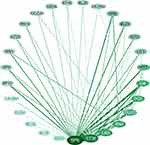 |
Figure 9 Diagram of the compatibility network of the three yin acupuncture points. Note: Only acupuncture points with a frequency of more than 100 are listed. |
SP6 were first seen in the “The AB Classic of Acupuncture and Moxibustion”, and SP6 belongs to the intersection point, because it is the intersection of the three yin meridians, so it is called the Sanyinjiao, of which later books such as “The Secret of the Outer Platform” are mentioned.8 SP6 belong to the spleen meridian, because it is the meeting point of the liver, spleen and kidney three yin meridians, which can be treated and treated for diseases of the meridians they meet, such as renal diseases, hepatobiliary diseases, and spleen and stomach diseases.9 “Great Compendium Acupuncture and Moxibustion”10 mentions the main treatment scope of SP6: “SP6, the main spleen and stomach are weak. Pregnancy fetal movement, horizontal birth, postpartum lochia is not good, excessive blood removal, blood collapse, unconsciousness”;11 it can be seen that the clinical application of SP6 is very wide, not only can treat the diseases that can be treated by this meridian, but also can treat other diseases. Anatomical studies have found that the nerve fibers innervating SP6 are mainly from the fourth lumbar vertebra to second sacral vertebra (L4-S2) nerve segment, the corresponding spinal cord segment is L4-S212 and the uterus corresponds to the second sacral vertebrae to fourth sacral vertebra (S2-S4) and twelfth thoracic vertebra to second lumbar vertebra (T12-L2) spinal cord segments, there are overlapping segments between them, most scholars believe that the distribution of the nerve segments of the uterus is the same or similar,13 so clinically the method of using SP6 single point or SP6 method to treat obstetrics and gynecology diseases related to the uterus. Among them, acupuncture analgesia can regulate all aspects of sensation, emotion, cognition and other aspects related to pain,14 so the frequency of use in primary dysmenorrhea and various preoperative and postoperative analgesia is very high. The occurrence of stroke is mainly due to abnormal cortico-spinal cord conduction signals, resulting in a series of various complications.15 Li Xiaoling16 believe that acupuncture of SP6 can play a therapeutic effect by regulating the functions of multiple brain regions such as thalamus and posterior central gyrus. Acupuncture can activate multiple brain regions of the brain, increase their signal intensity, improve brain area function, and thus affect the overall regulation of the brain on the human body,17 so SP6 has a more certain role in the treatment of neurology diseases. Insomnia is significantly correlated with the content of neurotransmitters such as hydroxytamine (5-HT), Noradrenaline (NE), Glutamic Acid (DA), and Aminobutyric Acid (GABA).18 Relevant studies19 have shown that acupuncture of relevant acupuncture points can effectively improve the sleep status of insomnia model rats, and increase the content of 5-HT in the brain and reduce the content of NE. Among them, HT7 and SP6 two acupoints have a particularly obvious effect on the increase of 5-HT and NE content, which is consistent with the data obtained by the association rules of insomnia in our statistics, among which the support of SP6 is as high as 80.723% with SP6, indicating that SP6 and HT7 can effectively alleviate the symptoms of insomnia.
Conclusion
This study systematically summarizes the dominant diseases of SP6 and provides a scientific reference for physicians, who can directly use SP6 and its acupoints for treatment of the above related diseases in clinical practice, such as SP6, DU20 and HT7 for insomnia, and SP6 and ST36 for primary dysmenorrhea. SP6 is a commonly used acupuncture point in clinical practice, the study of the application law and mechanism of SP6 is of great significance in the field of acupuncture and moxibustion, this study also provides a rich reference value for the study of the mechanism of SP6, we summarize the dominant diseases of SP6, so researchers can give priority to carry out animal experiments and related clinical studies around the dominant diseases of SP6 (such as insomnia), and conduct in-depth discussions on the compatibility law and mechanism of acupuncture points of SP6 based on this research. It provides a scientific reference for the study of SP6 mechanism and the optimization of clinical prescription for related diseases.
In short, the clinical application of the SP6 is extensive, experienced, and has a positive effect on the treatment of many diseases,20–33 and its clinical compatibility exists in certain rules. However, the matching law of SP6 as the main acupoint needs to be deeply explored from both clinical and basic aspects, such as a certain dominant disease treated with SP6 as the main acupoint, and several acupuncture points can achieve the peak effect?34,35 And is there a difference in the optimal needle retention time and acupuncture frequency for different diseases? Therefore, this study is the basis for future research on the mechanism of SP6 and provides a scientific reference for the optimization of clinical prescription of acupuncture.
At the same time, this study also has certain limitations, although the number of articles included is large (902 items), but mainly Chinese and English articles, not included in other languages, which may cause some bias to the results, we will include more databases in the future to increase the richness and credibility of the data. Through the evaluation of the literature quality of 902 studies, the overall literature quality was acceptable, but the description of scientific research details was not rigorous enough, because the number of literatures included in this study was large, which could avoid the bias of the results to a certain extent. The results of literature quality evaluation showed that 89% of the studies used the random method, but there was a lack of description of the type and details of the random method, how to perform the random allocation sequence, and how to hide the sequence number. Most studies omitted the calculation of sample sizes, reducing the reproducibility of the studies. Most of the studies described statistical methods, but the use of subgroup analysis and adjusted analysis was low, which reduced the scientific nature of the study to a certain extent, and statistical analysis of relevant outcome measures should be carried out according to a rigorous statistical process in the future. The lack of descriptions of dropout and exclusion in most studies reduced our confidence in the studies. Although the application rate of randomized controlled methods is high, the details of the study need to be further deepened, and future researchers should design research protocols according to rigorous scientific research processes to continuously improve the quality of RCTs and the credibility of clinical trial results.
Funding
This research was supported by the project of the National Key R&D Program of China (No2019YFC1712105), the Major Basic Research Project of Shandong Natural Science Foundation (No.ZR2020ZD17), the Research and Innovation Fund of Shandong University of Traditional Chinese Medicine (No. 2018-220315), the National Natural Science Foundation of China (No82205290), the National Natural Science Foundation of China (No82205290), Shandong Traditional Chinese Medicine Technology Project (No2021M144), and Shandong Traditional Chinese Medicine Technology Project (N02020Q007).
Disclosure
The authors report no conflicts of interest in this work.
References
1. Fang JQ, Zhao BX. Meridians and Acupoints.
2. Xu L, Peng YL. Overview of triple-negative intercourse in primary dysmenorrhea. Zhejiang J Traditional Chine Med. 2021;56(11):855–856. doi:10.13633/j.cnki.zjtcm.2021.11.041
3. Zeng F, Luo H. Literature research on the positioning and treatment of SP6. J Beijing Univ Chine Med. 2011;34(12):812–814.
4. Wu XD. Name and Positioning of Meridian Points (GB/T 12346–2021). Technol Health Care. 2021.
5. Gao JX, Li WY, Dong LY, et al. Quality evaluation of randomized controlled trials of patients undergoing nasal endoscopic surgery in enhanced recovery surgery based on CONSORT extended statement. Chin Med Abstracts. 2023;38(5):148–150+161+233. doi:10.19617/j.issn1001-1307.2023.05.148
6. Li ML, Zhu YZ, Zhang ZL, et al. Based on data mining technology, the main dominant diseases and matching rules of PC9 acupoint before 1949. Cli J Acupuncture. 2021;37(12):51–56. doi:10.19917/j.cnki.1005-0779.021244
7. Liu W, Jiang HL, Zhao XW, et al. Analysis of the application and combination rules of Sanyinjiao (SP 6) based on data mining. Int J Chine Materia Medica. 2023;45(1):95–99. doi:10.3760/cma.j.cn115398-20211006-00025
8. Chen XY, Yang L, Zou TT, et al. The evolution of SP6 has guiding significance for acupuncture in the treatment of insomnia. Shizhen Chine Med Chine Med. 2018;29(10):2454–2455.
9. Zhou HT, Zhou YL, Zheng MC, et al. Based on “Acupuncture and Moxibustion Dacheng”, the main treatment and matching rules of SP6 points are discussed. China Med Herald. 2023;20(02):152–155. doi:10.20047/j.issn1673-7210.2023.02.35
10. Jin Y, Wang W. Analysis of clinical application law of Yang Jizhou SP6. Zhejiang J Traditional Chine Med. 2017;52(06):433–434. doi:10.13633/j.cnki.zjtcm.2017.06.031
11. Li QL, Feng GX. Analysis of the clinical application law of Yannai Acupoint in Great Compendium Acupuncture and Moxibustion[J]. Asia-Pacific Traditional Med. 2023;19(01):196–199.
12. Cao RH, Qiao HF, Kou WQ. Law and theoretical discussion on acupoint sensitization of primary dysmenorrhea. World J Traditional Chine Med. 2022;17(11):1617–1620+1626.
13. Huang SY. Effects of moxibustion on spleen and kidney meridians in patients with yang deficiency and cold dysmenorrhea. Fujian Univ Chine Med. 2022. doi:10.27021/d.cnki.gfjzc.2022.000096
14. Xu YC, Jin ZS. Clinical research progress of acupuncture analgesia. Modern Clin Med. 2021;47(05):382–384.
15. Guo HF, Chen J, Yuan J, et al. Effect of repeated transcranial magnetic stimulation combined with magnetic stimulation of internal guan and SP6 in the treatment of patients with ischemic stroke and hemiplegia and its effect on functional imaging features. Clin Med Res Practice. 2022;7(23):27–30. doi:10.19347/j.cnki.2096-1413.202223008
16. LI XL, Cai L, Wang F, et al. Research progress of acupuncture SP6 brain functional magnetic resonance imaging. China Med Herald. 2018;15(25):29–31+35.
17. Liu H. Based on the cAMP/PKA-pCREB signaling pathway, the therapeutic effect and mechanism of acupuncture “DU20, PC6 and SP6” on neurological function in rats with cerebral ischemia. Tianjin Univ Chine Med. 2020. doi:10.27368/d.cnki.gtzyy.2020.000124
18. Wu QW, Zhu YH, Liu P, et al. Exploring the role of HT7 and SP6 in the treatment of insomnia from the perspective of sleep mechanism. Shizhen Chine Med Chine Med. 2014;25(02):402–403.
19. Liu C, Wei XC, Lu J. Mechanism and efficacy study of acupoint application in the treatment of insomnia in the past ten years. Smart Health. 2022;8(05):29–32. doi:10.19335/j.cnki.2096-1219.2022.05.009
20. Gao W, Yan Y. Transcutaneous electrical acupoint stimulation applied in lower limbs decreases the incidence of paralytic ileus after colorectal surgery: a multicenter randomized controlled trial. Surgery. 2021;170(6):1618–1626. doi:10.1016/j.surg.2021.08.007
21. Wang P, Zhang P, Ma L, et al. Immediate analgesic effect of needling acupoints (bilateral De Qi vs unilateral De Qi) on primary dysmenorrhea: a multi-center, randomized, controlled trail. J Tradit Chin Med. 2016;36(6):711–717. doi:10.1016/s0254-6272(17)30004-3
22. Li F, Qi Z, Hua L, et al. The efficacy of acupuncture for the treatment and the fertility improvement in child-bearing period female with Hashimoto Disease: a randomized controlled study. Medicine. 2020;99(27):e20909. doi:10.1097/md.0000000000020909
23. Fu KX, Hu JW. Efficacy of acupuncture combined with atropine combined with laughing gas in analgesia during abortion. Gansu Med Med J. 2015;34(08):572–574. doi:10.15975/j.cnki.gsyy.2015.08.005
24. Zhou XD. Randomized parallel-controlled study of spastic paralysis after stroke by acupuncture. J Practical Chine Int Med. 2015;29(06):152–153. doi:10.13729/j.issn.1671-7813.2015.06.69
25. Qiao RQ. Warm kidney solid spring ointment acupoint application warming acupuncture combined with western medicine in the treatment of urinary disorders after stroke: 225 cases. J Traditional Chine Med Res. 2018;31(07):60–63.
26. Aliyan A, Zhang M. Clinical observation of 175 cases of postoperative pain in the treatment of anorectal disease by acupoint stimulation combined with TCM differentiation and nursing. J Xinjiang Med Univ. 2009;32(07):986.
27. Weng XF. Study on the effect of traditional Chinese medicine nursing scheme on lower extremity deep vein thrombosis after knee arthroplasty. Massage Rehabilitation Med. 2017;8(14):62–64. doi:10.19787/j.issn.1008-1879.2017.14.028
28. Huang XJ, Hao X, Wang LL, et al. Analysis of the efficacy of traditional Chinese medicine ointment in the treatment of simple obesity. Sino-Foreign Med. 2019;38(15):169–172. doi:10.16662/j.cnki.1674-0742.2019.15.169
29. Yu XP. Clinical observation of acupuncture combined with less abdominal decoction in the treatment of uterine fibroids. J Traditional Chine Med. 2018;33(02):326–328. doi:10.16368/j.issn.1674-8999.2018.02.079
30. Feng FZ. Early interventional treatment of stroke acupuncture in 120 cases. Modern Distance Educ Chine Med. 2013;11(12):44–45.
31. Liu P, Qiu M, Wang H, et al. Clinical study on the prevention and treatment of hypotension in hemodialysis combined with moxibustion. Chine J Traditional Chine Med. 2014;29(02):553–558.
32. Yan Y. Clinical study of acupoint moxibustion on the prevention of uterine atony leading to postpartum hemorrhage. Guangzhou Univ Chine Med. 2016.
33. Pu QQ, Liu SY. Analysis and observation of the efficacy of acupuncture in 220 cases of knee osteoarthritis. China Health Industry. 2012;9(16):159. doi:10.16659/j.cnki.1672-5654.2012.16.025
34. Chen BW, Chen SZ, Liu CZ. Dose-response relationship between acupuncture and precision acupuncture treatment: a translational medicine perspective. Acupuncture Res. 2023;48(01):32–36. doi:10.13702/j.1000-0607.20220865
35. Chen S, Fang JQ, Jing XH. Study on acupuncture and composition rules in the treatment of irritable bowel syndrome. J Beijing Univ Chine Med. 2023;46(03):301–305.
 © 2023 The Author(s). This work is published and licensed by Dove Medical Press Limited. The full terms of this license are available at https://www.dovepress.com/terms.php and incorporate the Creative Commons Attribution - Non Commercial (unported, v3.0) License.
By accessing the work you hereby accept the Terms. Non-commercial uses of the work are permitted without any further permission from Dove Medical Press Limited, provided the work is properly attributed. For permission for commercial use of this work, please see paragraphs 4.2 and 5 of our Terms.
© 2023 The Author(s). This work is published and licensed by Dove Medical Press Limited. The full terms of this license are available at https://www.dovepress.com/terms.php and incorporate the Creative Commons Attribution - Non Commercial (unported, v3.0) License.
By accessing the work you hereby accept the Terms. Non-commercial uses of the work are permitted without any further permission from Dove Medical Press Limited, provided the work is properly attributed. For permission for commercial use of this work, please see paragraphs 4.2 and 5 of our Terms.
